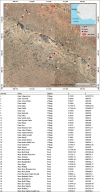Arboviruses isolated from the Barkedji mosquito-based surveillance system, 2012-2013
- PMID: 30541472
- PMCID: PMC6292156
- DOI: 10.1186/s12879-018-3538-2
Arboviruses isolated from the Barkedji mosquito-based surveillance system, 2012-2013
Abstract
Background: A mosquito-based arbovirus surveillance system was set up at Barkedji, Senegal after the first outbreak of Rift valley fever in West Africa in 1988. This system was recently updated using more sampling methods and collecting in greater number of ponds and villages sites.
Methods: For the current study, mosquitoes were sampled biweekly between July and December 2012 and 2013 using CDC+CO2 light traps set at ground and canopy level, mosquito nets baited with goat, sheep, human or chicken, light traps baited with goat, sheep and chicken; bird-baited traps using pigeons or chickens placed either at the ground or canopy level. Collected mosquitoes were identified, pooled and screened for arboviruses.
Results: A total of 42,969 mosquitoes in 4,429 pools were processed for virus isolation. Ten virus species were identified among 103 virus isolates. West Nile virus (WNV; 31 isolates), Barkedji virus (BARV; 18), Sindbis virus (SINV; 13), Usutu virus (USUV; 12), Acado virus (ACAV; 8), Ndumu virus (NDUV; 9), Sanar virus (SANV; 7), Bagaza virus (BAGV; 3), Rift valley fever virus (RVFV; 1), and Yaounde virus (YAOV; 1) were isolated from 9 ponds (91 strains) and 7 villages (12 strains). Only 3 virus species (WNV, NDU and SINV) were isolated from villages. The largest numbers of isolates were collected in October (29.1% of total isolates) and November (50.5%). Viruses were isolated from 14 mosquito species including Cx. neavei (69.9% of the strains), Cx. antennatus (9.7%), and Ma. uniformis (4.8%). NDUV, ACAV, and SINV are herein reported for the first time in the Barkedji area. Isolation of ACAV and SANV from a pool of male Ma. uniformis and USUV and BARV from a pool of male Cx. neavei, are reported for the first time to our knowledge.
Conclusion: Our data indicate that the Barkedji area is characterized by a high diversity of viruses of medical, veterinary and unknown importance. Arboviruses were first detected in July at the beginning of the rainy season and peaked in abundance in October and November. The Barkedji area, an enzootic focus of several potentially emerging arboviruses, should be surveilled annually to be prepared to deal with future disease emergence events.
Keywords: Aampling methods; Arbovirus; Mosquitoes; Ponds; Surveillance; Villages.
Conflict of interest statement
Ethics approval and consent to participate
Not applicable.
Consent for publication
Not applicable.
Competing interests
The authors declare that they have no competing interests.
Publisher’s Note
Springer Nature remains neutral with regard to jurisdictional claims in published maps and institutional affiliations.
Figures



Similar articles
-
Arbovirus surveillance from 1990 to 1995 in the Barkedji area (Ferlo) of Senegal, a possible natural focus of Rift Valley fever virus.J Med Entomol. 2001 Jul;38(4):480-92. doi: 10.1603/0022-2585-38.4.480. J Med Entomol. 2001. PMID: 11476327
-
Mosquito vectors of the 1998-1999 outbreak of Rift Valley Fever and other arboviruses (Bagaza, Sanar, Wesselsbron and West Nile) in Mauritania and Senegal.Med Vet Entomol. 2005 Jun;19(2):119-26. doi: 10.1111/j.0269-283X.2005.00564.x. Med Vet Entomol. 2005. PMID: 15958020
-
Evaluation of the Performance of Different Traps for Sampling Usutu and West Nile Viruses and Mosquito (Diptera: Culicidae) Vectors in Senegal.J Med Entomol. 2019 Jan 8;56(1):149-155. doi: 10.1093/jme/tjy145. J Med Entomol. 2019. PMID: 30124969
-
Present and future arboviral threats.Antiviral Res. 2010 Feb;85(2):328-45. doi: 10.1016/j.antiviral.2009.10.008. Epub 2009 Oct 24. Antiviral Res. 2010. PMID: 19857523 Free PMC article. Review.
-
Rift Valley Fever: An Emerging Mosquito-Borne Disease.Annu Rev Entomol. 2016;61:395-415. doi: 10.1146/annurev-ento-010715-023819. Annu Rev Entomol. 2016. PMID: 26982443 Review.
Cited by
-
Contemporary epidemiological data of Rift Valley fever virus in humans, mosquitoes and other animal species in Africa: A systematic review and meta-analysis.Vet Med Sci. 2023 Sep;9(5):2309-2328. doi: 10.1002/vms3.1238. Epub 2023 Aug 7. Vet Med Sci. 2023. PMID: 37548116 Free PMC article.
-
Serological Evidence of West Nile and Usutu Viruses Circulation in Domestic and Wild Birds in Wetlands of Mali and Madagascar in 2008.Int J Environ Res Public Health. 2020 Mar 18;17(6):1998. doi: 10.3390/ijerph17061998. Int J Environ Res Public Health. 2020. PMID: 32197367 Free PMC article.
-
Epidemiology of West Nile virus in Africa: An underestimated threat.PLoS Negl Trop Dis. 2022 Jan 10;16(1):e0010075. doi: 10.1371/journal.pntd.0010075. eCollection 2022 Jan. PLoS Negl Trop Dis. 2022. PMID: 35007285 Free PMC article.
-
Near-Complete Genome Sequence of Ndumu Virus from Garissa, Kenya, 1997.Microbiol Resour Announc. 2021 Aug 26;10(34):e0055121. doi: 10.1128/MRA.00551-21. Epub 2021 Aug 26. Microbiol Resour Announc. 2021. PMID: 34435864 Free PMC article.
-
Mosquito survey in Mauritania: Detection of Rift Valley fever virus and dengue virus and the determination of feeding patterns.PLoS Negl Trop Dis. 2022 Apr 15;16(4):e0010203. doi: 10.1371/journal.pntd.0010203. eCollection 2022 Apr. PLoS Negl Trop Dis. 2022. PMID: 35427361 Free PMC article.
References
-
- Traore-Lamizana M, Fontenille D, Diallo M, Ba Y, Zeller HG, Mondo M, Adam F, Thonon J, Maiga A. Arbovirus surveillance from 1990 to 1995 in the Barkedji area (Ferlo) of Senegal, a possible natural focus of Rift Valley fever virus. J Med Entomol. 2001;38(4):480–492. doi: 10.1603/0022-2585-38.4.480. - DOI - PubMed
MeSH terms
LinkOut - more resources
Full Text Sources
Medical

